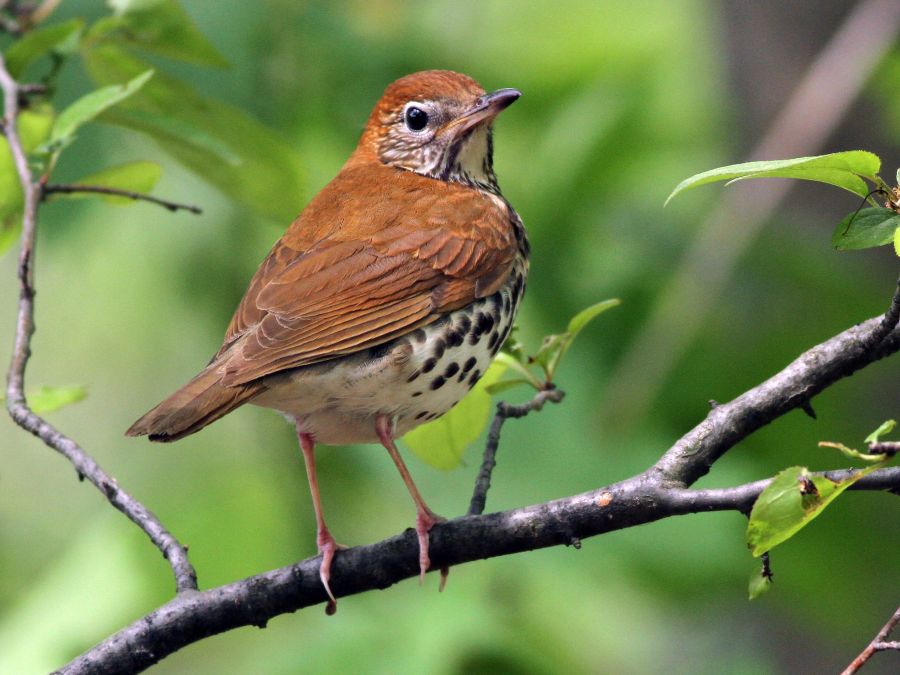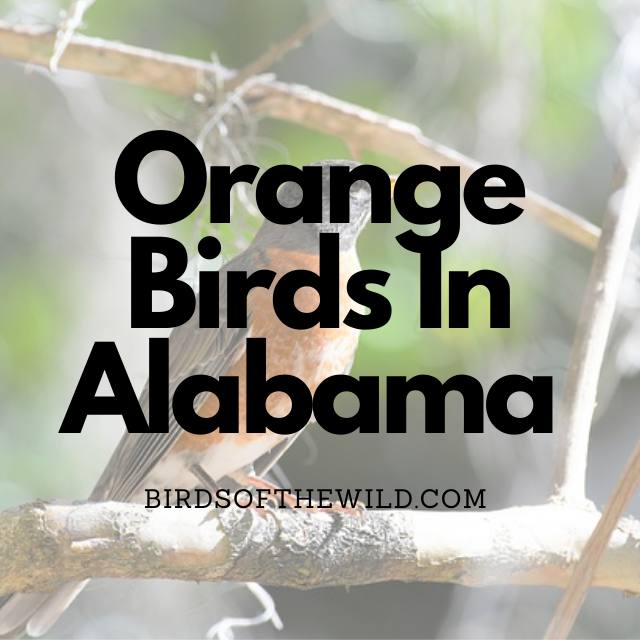Alabama is home to numerous birds coated in a variety of colors from green, yellow, red , blue and of course orange. In this article I’ll be going over 7 unique orange birds you can look out for the next time you find yourself outside looking to spot some avian wildlife.
- Brown Thrasher
- American Robin
- Baltimore Oriole
- Orchard Oriole
- Eastern Towhee
- American Kestrel
- Wood Thrush
7 Orange Birds In Alabama
1. Brown Thrasher (Toxostoma Rufum)

- Size: 23.5 – 30.5cm
- Weight: 61 – 89 grams
- Wingspan: 29 – 33cm
Brown thrashers can be found in Alabama year round as it is one of their permenant residencies within the States.
Brown thrashers (also refrred to as the fox colored thrush) are recognised by their brown plumage, with hues of a rusty orange color on the back of their head and breasts. The body is also patterned around the breast area where little blobs of brown are scattered throughout. Females have a very similar orange hue to their plumage too.
You’ll often find these thrashers around thickets around edges of deciduous or mixed woods, shrubby edges of swamps, around undergrowth in open pine woods as well as suburban neighbourhoods.
In regards to the food they eat, it consists of insects, berries and nuts with more than half of a brown thrashers diet consisting of insects like caterpillars, flies, true bugs, cicadas, grasshoppers etc.
Brown thrashers are know to live for around found 2 – 3 years on average, with the longest recorded lifespan being 12 years.
2. American Robin (Turdus Migratorius)

- Size: 12.5 – 14cm
- Weight: 16 – 22 grams
- Wingspan: 20 – 22cm
American robins can be found living in Alabama year round although further south of the state, some of these robins may only stay there when wintering.
These robins are recognised by by their gray wings, back and tail, black head, yellow beak and orange belly/breast. Females have a far duller color scheme where the plumage that is black is mostly gray whilst the breast is a lighter orange.
American robins are often seen around woodlands, suburban backyards, parks, and grasslands with shrubs.
As for what they eat, it includes fruits, seeds, suet, crushed peanuts, sunflower hearts, raisins and a variety of insects like beetles, flies, worms among many others.
American robins tend to live for an average of 2 years in the wild although some can live upto 5 or 6 years.
3. Baltimore Oriole (Icterus Galbula)

- Size: 15 – 20cm
- Weight: 38 – 43 grams
- Wingspan: 23 – 30cm
Baltimore orioles can be found in Alabama when it’s breeding season. This begins between April and May. Further south of the state, some baltiomore orioles tend to make their migratory passage through Alabama.
Baltimore orioles are recognised by their orange/yellow, black and white plumage, where their head and wings are black in color, their breast and underside of the tail orange/yellow, with a beak that’s black in color. Females are very similar in color besides their head which isn’t black like the males.
Baltimore orioles can be found living around open deciduous woodlands where they will build their nests within American elms, cottonwoods, and maples.
In regards to what these orange and black birds eat, it includes a variety of small insects like ants, wasps, beetles, grasshoppers, flies among others, flower nectar and smaller fruits like berries. They also feed on sugar water found within feeders.
A baltimore oriole ten to have lifespan of around 11 years in wild.
4. Orchard Oriole (Icterus Spurious)

- Size: 15 – 18cm
- Weight: 16 – 28 grams
- Wingspan: 23 – 27cm
These orioles tend to spend their breeding season in Alabama which starts around late April to late May.
Orchard orioles tend have an orange breast and belly with their neck, head and a back black in color. Females are almost completely yellow with elements of of gray throughout their body.
They will often be located around semi-open habitats with deciduous trees and open space, including riverside trees, orchards, suburbs, forest edges, forest clearings and prairie groves.
Orchard orioles also eat a bunch of different food sources such as insects, nectar from flowers, sugar water from feeders and a number of other smaller berries and fruits.
Orchard orioles tend to live for around 11 years in the wild.
5. Eastern Towhee (Pipilo Erythrophthalmus)

- Size: 17 – 23cm
- Weight: 35 – 45 grams
- Wingspan: 20 – 30cm
Eastern towhees can be found in Alabama year round as it is a permenant residence of theirs.
Towhees are recognised by their black, white and orange feathers with their back, head and wings black in color, their side chest orange in color with the underside of the breast white in color. Females follow a similar plumage color scheme but their back is a duller gray color with the breast a mixture of orange and white.
These avians will spend the majority of their time staying at open woods, undergrowth, brushy edges where they prefer being around ground cover to forage for food.
Eastern Towhee consume a unique amount of different food sources such as insects like beetles, caterpillars, moths, true bugs, ants, spiders, snails, and millipedes, smaller reptiles like salamanders, lizards, or snakes, seeds, acorns, berries, and smaller fruits.
Eastern Towhees are known to live for around 12 years in the wild.
6. American Kestrel (Falco Sparverius)

- Size: 20 – 24cm
- Weight: 115 – 125 grams
- Wingspan: 50 – 60cm
American kestrels can be found around Alabama year round.
These kestrels are recognised by their spotted orange, gray, black and white plumage with their back orange with a black horizontal pattern, their wings a gray color, black tail feathers and orange sides with a gray and white head that has 2 black lines drawn vertically near both eyes. Females are mostly light brown.
American kestrels can be found in a variety of open or semi-open habitats from forest clearings, farmland and deserts.
As for what they eat, it includes small mammals such as woodmice and shrews, small birds, insects, earthworms with voles being their go to food source.
Wild Ameican kestrels are known to live for around 5 years but, captive variants have been known to hit 17+ years.
7. Wood Thrush (Hylocichla Mustelina)

- Size: 17 – 20cm
- Weight: 45 – 50 grams
- Wingspan: 31 – 33cm
Wood thrushes can be found in Alabama when they happen to breed. These months tend to range from April – August.
These birds are recognised by their ginger/orange back and upper head, with the wings a brown color and the breast is white with a black spotted pattern to their sides. Females look relatively the same but, may have a slightly duller hue to their plumage.
You can locate a wood thrush around deciduous and mixed forests which include older forests with shrubs in the understory that have trees taller than 16 meters, with moist soil and leaf litter on the ground.
Insects, berries and small fruits make up the majority of their diets so, you will see wood thrushes chowing down on their fair share of caterpillars, beetles, flies, ants, crickets etc.
A wood thrush will live for around 4 – 5 years on average, whilst the longest recorded lifespan was around 8 years and 11 months.
Amhil Khan, a dedicated nature enthusiast and the founder of BirdsOfTheWild.com, is a passionate advocate for the captivating world of avian wonders. With a deep-seated curiosity about the intricate lives of birds, Amhil’s journey began as a fascination and has evolved into a mission to inspire others to appreciate and protect these magnificent creatures.
Amhil’s love for birds led to the creation of Birds of the Wild, a platform where his expertise in ornithology, coupled with his captivating storytelling, provides readers with an immersive and educational experience. Through his lens and words, he captures the essence of birds in their natural habitats, offering a glimpse into their behaviors, migrations, and the ecosystems they inhabit.

